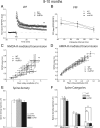Age-dependent impairment of spine morphology and synaptic plasticity in hippocampal CA1 neurons of a presenilin 1 transgenic mouse model of Alzheimer's disease
- PMID: 19675248
- PMCID: PMC6664983
- DOI: 10.1523/JNEUROSCI.1856-09.2009
Age-dependent impairment of spine morphology and synaptic plasticity in hippocampal CA1 neurons of a presenilin 1 transgenic mouse model of Alzheimer's disease
Abstract
Presenilin 1 (PS1) mutations are responsible for a majority of early onset familial Alzheimer's disease (FAD) cases, in part by increasing the production of Abeta peptides. However, emerging evidence suggests other possible effects of PS1 on synaptic dysfunction where PS1 might contribute to the pathology independent of Abeta. We chose to study the L286V mutation, an aggressive FAD mutation which has never been analyzed at the electrophysiological and morphological levels. In addition, we analyzed for the first time the long term effects of wild-type human PS1 overexpression. We investigated the consequences of the overexpression of either wild-type human PS1 (hPS1) or the L286V mutated PS1 variant (mutPS1) on synaptic functions by analyzing synaptic plasticity and associated spine density changes from 3 to 15 months of age. We found that mutPS1 induces a transient increase observed only in 4- to 5-month-old mutPS1 animals in NMDA receptor (NMDA-R)-mediated responses and LTP compared with hPS1 mice and nontransgenic littermates. The increase in synaptic functions is concomitant with an increase in spine density. With increasing age, however, we found that the overexpression of human wild-type PS1 progressively decreased NMDA-R-mediated synaptic transmission and LTP, without neurodegeneration. These results identify for the first time a transient increase in synaptic function associated with L286V mutated PS1 variant in an age-dependent manner. In addition, they support the view that the PS1 overexpression promotes synaptic dysfunction in an Abeta-independent manner and underline the crucial role of PS1 during both normal and pathological aging.
Figures





Similar articles
-
Presenilin transgenic mice as models of Alzheimer's disease.Brain Struct Funct. 2010 Mar;214(2-3):127-43. doi: 10.1007/s00429-009-0227-3. Epub 2009 Nov 18. Brain Struct Funct. 2010. PMID: 19921519 Free PMC article. Review.
-
Presenilin-1 mutation impairs cholinergic modulation of synaptic plasticity and suppresses NMDA currents in hippocampus slices.Neurobiol Aging. 2009 Jul;30(7):1061-8. doi: 10.1016/j.neurobiolaging.2007.10.009. Epub 2008 Feb 20. Neurobiol Aging. 2009. PMID: 18068871 Free PMC article.
-
Synaptic transmission and hippocampal long-term potentiation in transgenic mice expressing FAD-linked presenilin 1.Neurobiol Dis. 1999 Feb;6(1):56-62. doi: 10.1006/nbdi.1998.0207. Neurobiol Dis. 1999. PMID: 10078973
-
Modulation of synaptic plasticity and Tau phosphorylation by wild-type and mutant presenilin1.Neurobiol Aging. 2008 May;29(5):639-52. doi: 10.1016/j.neurobiolaging.2006.11.019. Epub 2007 Jan 12. Neurobiol Aging. 2008. PMID: 17222948
-
Age-related progressive synaptic dysfunction: the critical role of presenilin 1.Rev Neurosci. 2010;21(4):239-50. doi: 10.1515/revneuro.2010.21.4.239. Rev Neurosci. 2010. PMID: 21086758 Review.
Cited by
-
NMDA Neurotransmission Dysfunction in Behavioral and Psychological Symptoms of Alzheimer's Disease.Curr Neuropharmacol. 2012 Sep;10(3):272-85. doi: 10.2174/157015912803217288. Curr Neuropharmacol. 2012. PMID: 23450042 Free PMC article.
-
Effects of long-term treatment with pioglitazone on cognition and glucose metabolism of PS1-KI, 3xTg-AD, and wild-type mice.Cell Death Dis. 2012 Dec 20;3(12):e448. doi: 10.1038/cddis.2012.189. Cell Death Dis. 2012. PMID: 23254291 Free PMC article.
-
Presenilin transgenic mice as models of Alzheimer's disease.Brain Struct Funct. 2010 Mar;214(2-3):127-43. doi: 10.1007/s00429-009-0227-3. Epub 2009 Nov 18. Brain Struct Funct. 2010. PMID: 19921519 Free PMC article. Review.
-
Altered learning, memory, and social behavior in type 1 taste receptor subunit 3 knock-out mice are associated with neuronal dysfunction.J Biol Chem. 2017 Jul 7;292(27):11508-11530. doi: 10.1074/jbc.M116.773820. Epub 2017 May 18. J Biol Chem. 2017. PMID: 28522608 Free PMC article.
-
Increased expression of AT-1/SLC33A1 causes an autistic-like phenotype in mice by affecting dendritic branching and spine formation.J Exp Med. 2016 Jun 27;213(7):1267-84. doi: 10.1084/jem.20151776. Epub 2016 May 30. J Exp Med. 2016. PMID: 27242167 Free PMC article.
References
-
- Alvarez VA, Sabatini BL. Anatomical and physiological plasticity of dendritic spines. Annu Rev Neurosci. 2007;30:79–97. - PubMed
-
- Barrow PA, Empson RM, Gladwell SJ, Anderson CM, Killick R, Yu X, Jefferys JG, Duff K. Functional phenotype in transgenic mice expressing mutant human presenilin-1. Neurobiol Dis. 2000;7:119–126. - PubMed
-
- Bonny C, Oberson A, Negri S, Sauser C, Schorderet DF. Cell-permeable peptide inhibitors of JNK: novel blockers of beta-cell death. Diabetes. 2001;50:77–82. - PubMed
-
- Citron M, Westaway D, Xia W, Carlson G, Diehl T, Levesque G, Johnson-Wood K, Lee M, Seubert P, Davis A, Kholodenko D, Motter R, Sherrington R, Perry B, Yao H, Strome R, Lieberburg I, Rommens J, Kim S, Schenk D, et al. Mutant presenilins of Alzheimer's disease increase production of 42-residue amyloid beta-protein in both transfected cells and transgenic mice. Nat Med. 1997;3:67–72. - PubMed
Publication types
MeSH terms
Substances
LinkOut - more resources
Full Text Sources
Medical
Molecular Biology Databases
Miscellaneous
